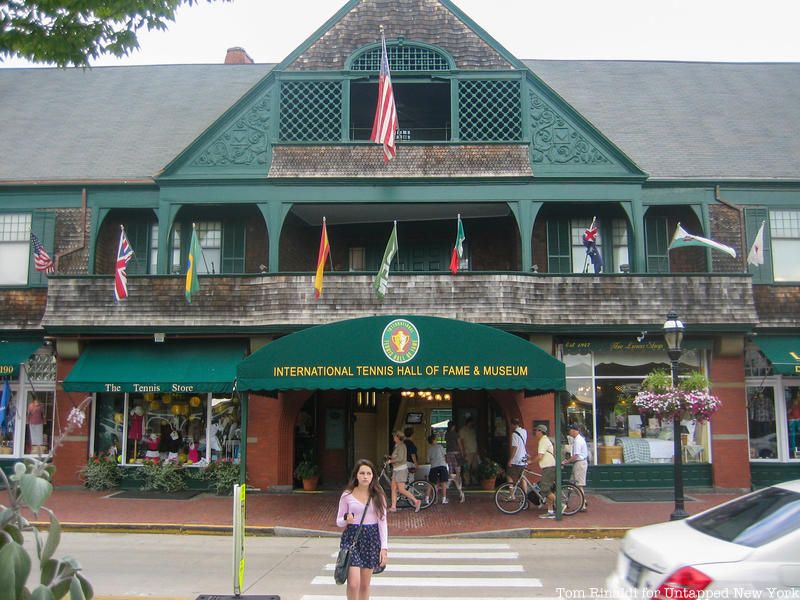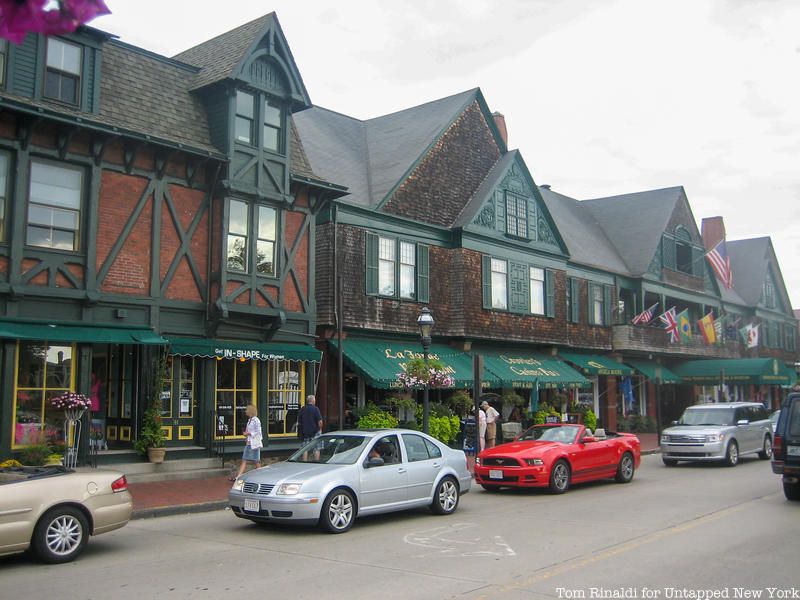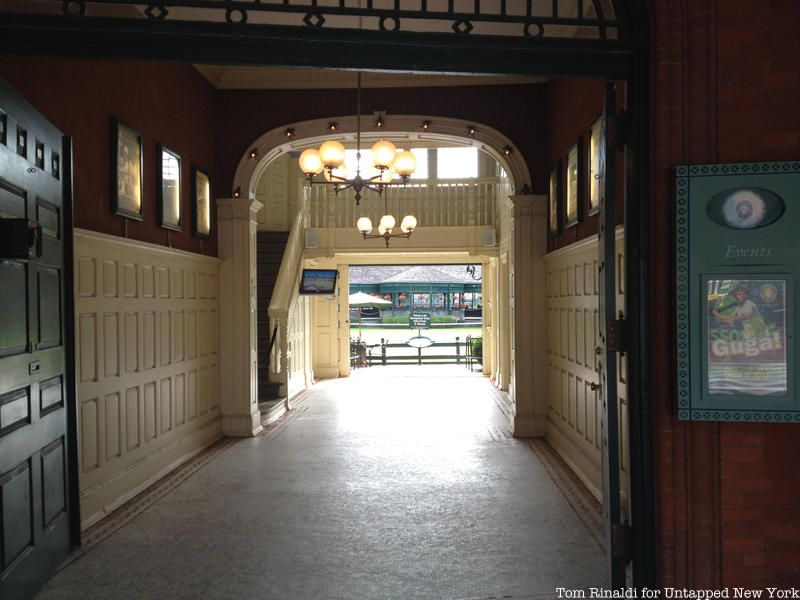NYC’s Forgotten ‘War on Christmas Trees’
Discover how an obscure holiday crackdown affects festive street vendors today!


Before Flushing Meadows, even before Forest Hills, the U.S. Open Tennis Tournament’s first home was in Newport, Rhode Island at what is now the International Tennis Hall of Fame. When the national tennis tournament began, it was located in the Newport Casino, a social club commissioned by newspaper owner James Gordon Bennett Jr. of the New-York Herald. Legend has it that in 1879, Bennett lost a bet with his polo partner, Captain Henry Augustus Candy, whom he dared to ride a horse onto the porch of the Newport Reading Room, an exclusive social club in town. Candy allegedly rode his horse right into the club itself and subsequently lost his membership. Thus, the idea of a new social club was born. In reality, writes the International Tennis Hall of Fame, Bennett already had designs on creating another social club in Newport by that point, to be located across from his home, the Stone Villa.
Bennett Jr. hired his favorite architects, Charles McKim and Stanford White, of McKim, Mead & White. White also designed the Venetian-palazzo inspired headquarters of the New York Herald for Bennett Jr., on the site that is now Herald Square. The Newport Casino was never a place for gambling, but the word casino was a term for a social club during the Gilded Age, derived from the Italian word casa.

Photos by Thomas Rinaldi, author of New York Neon and Hudson Valley Ruins
The shingled, manor-style complex was intended to feel like the country clubs of England, which makes sense given that the American elite of this era were desperate to demonstrate to its European counterparts that it was its equivalent. The creation of Central Park and Prospect Park fall into this effort, along with the modeling of Eastern Parkway in Brooklyn after the Champs-Élysées and Avenue Foch in Paris. The whole scale importation of chateaus by robber barons like the Vanderbilts and other new money men (and women) also rounded out the Europeanization of America during this time.

The Newport Casino opened on July 26th, 1880. In a way, the complex is a great example of mixed-use urban architecture before it was a concept – one reason it is still standing today. The facade along Bellevue Avenue is lined with small-scale storefront retail, which today includes a restaurant, clothing retailers, a home decor shop, and the Tennis Hall of Fame shop. An open arcade through the front facade offers a view of the grass tennis court in the inner courtyard. On the second floor are club facilities, which included a billiard room, reading rooms, and other club rooms.

The fairly extensive grounds included lawn tennis courts, an indoor facility with more tennis courts, a bowling alley, and an ornate 500-seat theater. A wide range of activities took place inside the Newport Casino, including “Archery, billiards, concerts, dancing, dining, horse shows, lawn bowling, reading, tea parties and theatricals, along with the staples of its present day offerings of lawn tennis, croquet, and court tennis.”

A little over a year after its opening, on August 31, 1881, the first-ever U.S. National Men’s Singles Championship was held at the Newport Casino. 25 people competed and a string quartet provided musical entertainment. Dick Sears would be crowned the first men’s singles champion, winning the next six tournaments and then retiring. He would also win the doubles championships five times.
The U.S. National Championship for tennis at the Newport Casino was by all accounts, more of an upper crust, society event. Until 1886, the tournament was also mens-only. The U.S. Women’s National Singles Championship started in 1887 and was held in Philadelphia at the Philadelphia Cricket Club.

The push to move the tournament to New York City began as early as 1911, by a group of New York tennis players. Space was also becoming a constraint for the growing event. A New York Times article from February 1911 that covered a contentious vote about the club’s move stated that “the arguments were powerfully arrayed against Newport,” but there was no “bona-fide application from any responsible club to hold the tournament elsewhere.” As a result, those in favor of thew move lost the vote 60 to 95. By 1915, however, 100 members signed a petition to move the club and won the official vote.

Entrance to the West Side Tennis Club
From 1915 to 1921, the tournament was located at the West Side Tennis Club in Forest Hills, Queens, with a brief few years at the Germantown Cricket Club in Philadelphia while the Forest Hills Tennis Stadium was being built. In 1968, the tournament became the U.S. Open and in 1978, the tournament moved to Flushing Meadows-Corona Park to accommodate larger crowds, although the West Side Tennis Club attempted to block the move.

US Open at Flushing Meadows
Meanwhile, back in Newport, the International Tennis Hall of Fame was founded in 1954 by Jimmy Van Alen, who was President of the Newport Casino, and his wife Candy. Inspired by a visit to the National Baseball Hall of Fame, the couple “decided that tennis also needed a place to honor its great figures,” according to the International Tennis Hall of Fame. In the early 1950s, the Newport Casino was in a difficult financial position and targeted for potential demolition and redevelopment.

The Van Alens purchased the club property to save it, and the idea for a Tennis Hall of Fame ushered in a new life for the historic club. Thanks to the Van Alens’ efforts, the United States Lawn Tennis Association approved of the creation of what was first the National Lawn Tennis Hall of Fame and Museum. In 1986, the Hall of Fame was recognized by the International Tennis Federation and the Newport Casino complex was designated a National Historic Landmark in 1987.
This year’s US Open Tennis Championships, which began yesterday, will occur without fans due to the coronavirus pandemic but will still be broadcasted. To see the 2020 US Open schedule of play, click here. Several players, including last year’s men’s and women’s champions Rafael Nadal and Bianca Andreescu have chosen not to compete due to coronavirus concerns. Fan favorite Naomi Osaka has chosen to wear her mask, emblazoned with the name of Breonna Taylor, throughout the tournament.
Join us for an upcoming tour of the Remnants of the World’s Fairs in Flushing Meadows-Corona Park, where the US Open is located today:
Next, check out the Top 10 Secrets of the US Open. Stay tuned for more historical coverage of the US Open Tennis Championship here at Untapped New York!
Subscribe to our newsletter